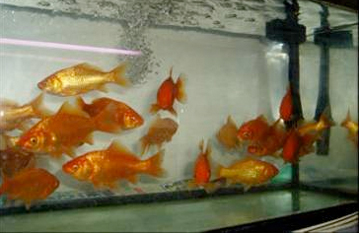A Fate More Honorable Than Sushi
|
|
Coal miners used canaries to warn them of noxious gases for generations. Today’s substitute may be the everyday goldfish: it can act as an aquatic canary to warn scientists when something bad is brewing in the waters, according to new research.
Scientists regularly monitor pollution in freshwater to understand the hazards threatening people who use it. This often requires examining the effects of the water in different organisms, ranging from bacteria to amphibians. Researchers in Asia have successfully screened freshwater for certain carcinogens by studying Salmonella bacteria and different species of fish. However, tests using Salmonella could yield false results, and researchers would prefer using a single species of fish to test for different pollutants.
|
|
A new study combines several environmental screens into one species of goldfish. Goldfish can adapt to any freshwater environment, says researcher Yuya Deguchi of Nagasaki International University in Japan. This trait, along with their size, makes goldfish an ideal model species to observe, Deguchi says. His team bought 10 male goldfish and exposed them to water from the Ho River near the region’s textile dyeing factory. In the laboratory, five goldfish swam in water collected upstream of the factory; the other five swam in water collected downstream. Earlier laboratory screens using Salmonella revealed carcinogens in this river, but the team expanded its study to track three biological measurements: damage to the fishes’ DNA; synthesis of a protein normally only seen in the livers of females; and production of enzymes associated with certain pollutants.
The team examined the fish at two one-week intervals. Goldfish exposed to water downstream of the factory produced more of the female liver protein and more of one pollutant-generated enzyme than the upstream fish. Water from both points in the river damaged the fishes’ DNA, although water from downstream inflicted more damage. The results, published in the December issue of Environmental Toxicology, confirm the earlier Salmonella screens for carcinogens and suggest the factory also pollutes the river with endocrine-disrupting compounds. More broadly, the team feels the study validates the goldfish as a model chemical screener.
Carys Mitchelmore of the University of Maryland Center for Environmental Science says combining several assays into one fish species is not novel, but is certainly the right direction for assessing the health of rivers. Exposing five fish to river water in the laboratory is not ideal, Mitchelmore says, adding that a more extensive study should use fish collected from the river at different times of the year, maybe even confining fish to cages in the river itself.
Emmanuel Bantugan Romero is graduate student in the Science Communication Program at UC Santa Cruz
